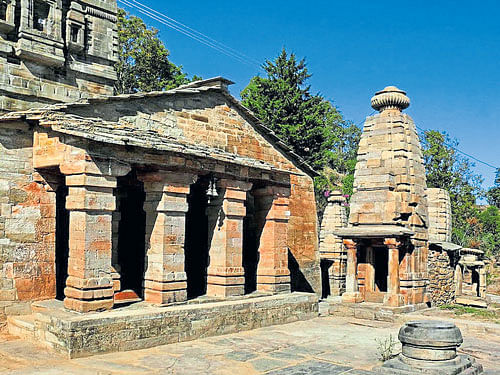
Sometimes, good things happen by accident. I can confidently say that I discovered Almora quite accidentally, and I am happy about it. Well, it happened like this. I was holidaying in Nainital with my family, and as the day of departure was drawing near, I realised how much I enjoyed the pristine beauty of Uttarakhand.
To my good fortune, my trip got extended by three whole days. I frantically researched about places around Nainital that I could visit. That was when I chanced upon Almora, and decided to explore the place.
At just around 63 km from Nainital, Almora is a treasure trove of surprises. With greenery till the eyes can reach, and the snow-capped Himalayan peaks in the background, the drive up to Almora was in itself a delightful experience. Thick forests of pine and fir trees seemed to hold within them all the secrets of nature. Throughout my drive, the only sounds that accompanied me were the chirping of birds and the swooshing of winds. And, of course, the soothing sound of water flowing close by, which, I later learnt were the rivers Koshi and Suyal.
With only three days at my disposal, I meticulously planned my stay in Almora. The best part about this quaint hill station is that it offers a variety of options to its visitors. While the adventurous can plan trekking trails with Almora as base, the religious can go temple-hopping as it is home to several temples, and wildlife lovers can visit the Binsar Wildlife Sanctuary.
Local lores
Situated on a horseshoe-shaped ridge of a mountain, at an elevation of 1,638 metres above sea level, Almora has a fascinating history. Founded in 1568 by King Kalyan Chand, it was the seat of Chand kings who ruled over the Kumaon kingdom. The place got its name from kilmora, a wild edible plant grown extensively here, I was told. According to locals, at the 800-year-old Katarmal Temple here, kilmora plant was used to wash vessels and the people who brought it were known as kilmori, which later became Almori, and eventually Almora.
After a long trek that left me asking for more, I enjoyed some quiet time outside my cottage with a hot cup of coffee in my hand. The ‘special’ Almora coffee I was served was indeed special, and as a bonus, I was also treated to an Almori sweet called bal mithai made of khoya and cane sugar.
Next morning, waking up to the chirping of birds, I looked out of the window, only to see white clouds descending on a carpet of green Almora was. After a good breakfast, I set out on my temple visits. My first stop was at Kasar Devi Temple, dedicated to goddess Kasar Devi, the presiding deity of Almora. According to locals, Swami Vivekananda had meditated at this temple during his stay in Almora.
The temple that took my breath away was the Katarmal Sun Temple, second only to the Sun Temple in Konark. Built by King Katarmalla, a Katyuri king, in 9th century, this temple complex is unique in its design, structure and carvings. Walking from one shrine to another in this complex that houses over 40 smaller shrines, admiring its architectural beauty, I was lost in time.
I quickly made my way back to Almora town, as I wanted to be at Bright End Corner, famed for its sunrise and sunset views. I made it in time for nature’s spectacle. Just before the sun dipped below the horizon, the sky was a bright shade of orange. My jaw dropped. I spent a few quiet moments marvelling at the mystique of nature.
Cloaked in tranquility
Nights in Almora were as quiet as quiet could be. Lulled to sleep by the melodic trills of insects, I alternated between deep slumber and dreamy wakefulness. Waking up the next morning to the song of a whistling thrush, I realised it was my last day in the scenic town. I wanted to make the most of it. The choice was between exploring the town and visiting the Binsar Wildlife Sanctuary. I settled for the former.
I set out on my mission for the day with a visit to Lal Bazaar. Walking down the cobbled alleys of this bazaar, I acquainted myself with the specialities of the town — garments made from the fur of angora rabbits, traditional copperware known locally as tamta, Himalayan wool, Kumaoni-style jewellery, etc. I also strolled around Chowk Bazaar, which was equally mesmerising. My interactions with the locals in these bazaars left me in awe of their simplicity and gentle nature. Sipping chai at a roadside shop, watching the leisurely pace of the locals, I already knew I would miss this idyllic setting.
Fact file
How to get there:
By road: It is well-connected by road to most major cities in the North.
By air: The nearest airport is Dehra Dun Airport, 173 km away.
By rail: The nearest railway station is Kathgodam, 38 km away.
What to see:
Bright End Corner, Binsar Wildlife Sanctuary, Kansar Devi Temple, Katarmal Sun Temple, Gobind Vallabh Pant Museum, Kumaon Regimental Centre Museum, Kalimut, Martola.